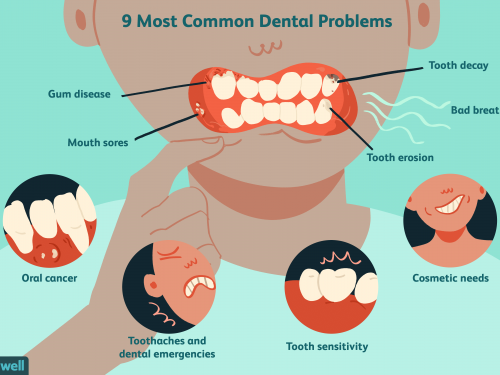

Hygienic measures and carelessness regarding the teeth and oral health leads to various teeth and gums disorders. Healthcare Solutions has studied the 2 Infections that affect the mouth and teeth given as follows.
Periodontal disease
Periodontal disease is an inflammatory disease of the periodontal tissues, characterized by inflammation of the gums, destruction of the connection between the gum and the body of the
tooth, leading to the loss of teeth from initially healthy teeth due to strong mobility. Periodontal disease is infectious in nature. The infection penetrates between the tooth and the gum, gradually disrupting the connection of the root of the tooth with the bone, contributing to an increase in the mobility of the tooth in place, over time, the connection between the root and the bone is interrupted, the tooth dies and falls out. Absolutely healthy teeth that are not affected by other dental pathologies can be affected by periodontal disease. When an infection is detected, it is not difficult to eliminate its pathogens, however, in this case, the consequences of periodontal disease are important. Since after the destruction of the infection, the soft tissues of the gums are quickly restored, and not the junction of the root of the tooth with the bone, the resulting cavity is filled with soft tissues, contributing to the excessive mobility of the tooth and, again, its subsequent loss. Thus, the treatment of periodontal disease consists of two main parts: the destruction of the infection, the restoration of bone tissue and the connection of the tooth roots with the bone tissue.
Infections that affect the mouth and teeth
Treatment of periodontal disease
After a course of treatment of periodontal disease at Hayatmed Clinic in Turkey, the patient needs to pay special attention to hygiene procedures for a long time, monitor the condition of the teeth and regularly visit the dentist. Often, as a preventive measure, the doctor prescribes special care for the teeth and gums using specialized means for cleaning teeth and oral hygiene.
It should be remembered that even a completely cured periodontal disease can develop again under unfavorable conditions. Preventive measures are: observance of hygiene of the oral cavity, teeth, gums; timely visits to the dentist; systematic self-monitoring of dental health.
Infections that affect the mouth and teeth
Gum disease
Pulpitis
Pulpitis is an inflammatory disease of the soft tissues of the tooth, which has an infectious nature, which is the most common consequence of untimely or poor-quality treatment of carious lesions, characterized by acute pain, a sharp reaction to temperature stimuli.
See Also: Vidalista treating ED and maintaining long time erection
Pulpitis is not so much an independent disease as a consequence of improper treatment of dental diseases or lack of treatment as such. The mechanism of development of the disease is simple: in the presence of neglected carious lesions, the destruction of hard tooth tissues can
reach the root pulp, as a result of which microorganisms and their waste products begin to penetrate into the vascular bundle located in the center of the tooth. The ingress of pathogenic agents is accompanied by a response, accompanied by acute pain, a sharp, long-term reaction to cold or hot – this is inflammation. In addition to caries, pulpitis can be triggered by trauma to the tooth – loss of part of the tooth or crown, fracture, crack.
Infections that affect the mouth and teeth
Symptoms of Pulpitis
The symptoms of pulpitis are varied and depend on the form of the course of the disease.
Distinguish between acute and chronic forms of the disease. Acute pulpitis is characterized by recurrent tooth pain that occurs suddenly and disappears on its own. Most often, pain occurs in the evening and at night. At the initial stages of the development of the disease, pulpitis may not bother the patient much, however, over time, the attacks of pain become more frequent and intensified, the pain becomes pulsating, expressed in greater intensity. Sometimes the pain radiates to the jaw, ear, adjacent areas, and can cause a migraine attack or headache. In the future, the pain becomes unbearable, excruciating and cannot be relieved by pain relievers.
Infections that affect the mouth and teeth
Chronic pulpitis manifests itself in a slightly different way. This disease in a chronic form makes itself felt with any thermal changes – painful sensations arise when the temperature changes, for example, when moving from a cold room to a warm one and vice versa, using a very cold or very hot one. As the thermal factor is removed, the pain gradually subsides. Spontaneous unreasonable pain is not typical for chronic pulpitis.
Pulpitis treatment
Pulpitis treatment involves removing the pulp, placing a filling on the damaged tooth. In the absence of treatment for pulpitis, a number of complications and consequences may develop.
The most common are: periodontitis, periostitis; osteomyelitis, etc.
How gum and dental diseases manifest
Regardless of the nature and complexity, dental diseases must be treated. Persons who visit the dentist at least twice a year, by regular visits to the doctor, protect themselves from the development of dental pathologies and dental diseases. A timely visit to a doctor allows not only to carry out gentle treatment and prevent the development of the disease, but also to completely eliminate the consequences of the disease. Untimely access to a doctor can lead to the development of complications, the appearance of concomitant diseases, damage to healthy teeth, tooth loss and impaired chewing functions.
The following symptoms are the reason for going to the doctor:
- discoloration of the tooth;
- The appearance of painful and uncomfortable sensations in the tooth or surrounding tissues;
- A sharp reaction of the teeth to cold and hot foods;
- Mechanical damage to the tooth;
- Bad breath;
- Presence of tartar and abundant plaque.
Leave a Reply